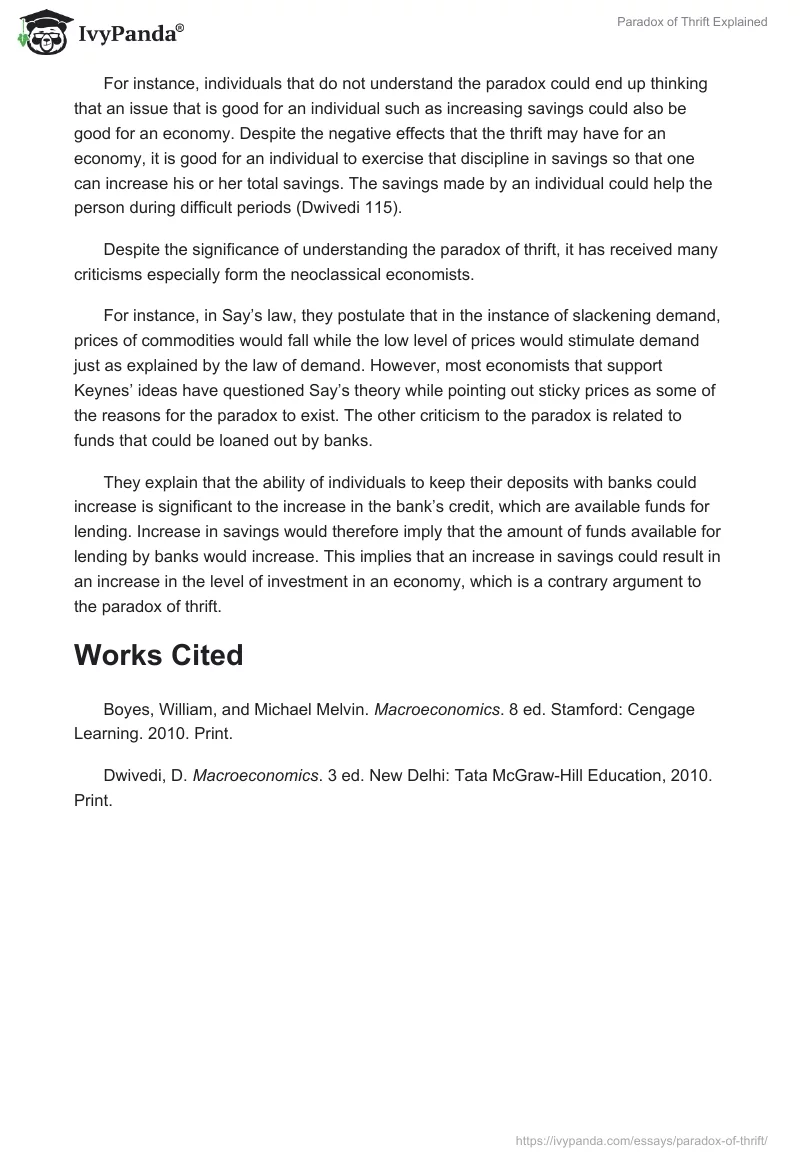This is an economic concept that was coined by Maynard Keynes where he argued that the increase in the savings of individuals during a time when the economy was in a recession could result in overall decline of the aggregate demand in the economy and would end up leading to overall decline in the national savings. Keynes argued that the decrease in the economic growth of a country together with the aggregate demand could result in reduced economic productivity thereby resulting in overall decline in the national savings (Dwivedi 115).
Therefore, the paradox arises when the total savings of an economy decrease even when individuals in the country have increased their levels of savings. This is a narrow perspective of the paradox that focuses on the individual savings. On the broader perspective, an increase in individual savings may be harmful to an economy since the consumers would focus so much on savings and forget to spend thereby leading to overall reduction in the aggregate demand hence the poor performance of the economy.
According to Boyes and Melvin (222), the narrow perspective of the paradox contradicts the assumption while the broader perspective of the paradox contradicts the claim through implication since it is expected that when individuals increase their savings, it is good for the economy.
The argument postulated by the paradox is that the total income in an economy must equal the total output when the market is at symmetry while all savings in the economy must equal all investments made in the economy (Boyes and Melvin 222). It is assumed that the level of savings increases faster then income increased as compared to the increase in the level of investment as output increases.
Therefore, the marginal propensity to save is likely to move the point of equilibrium at which income equates output as investment equates savings at lower levels. The paradox is similar to the prisoner’s dilemma since the savings made by individuals could be beneficial to them. However, the same savings could be disastrous to the general economy of a country. The scenario presented is a paradox since the intuition created is that of contrary intuition.
For instance, individuals that do not understand the paradox could end up thinking that an issue that is good for an individual such as increasing savings could also be good for an economy. Despite the negative effects that the thrift may have for an economy, it is good for an individual to exercise that discipline in savings so that one can increase his or her total savings. The savings made by an individual could help the person during difficult periods (Dwivedi 115).
Despite the significance of understanding the paradox of thrift, it has received many criticisms especially form the neoclassical economists.
For instance, in Say’s law, they postulate that in the instance of slackening demand, prices of commodities would fall while the low level of prices would stimulate demand just as explained by the law of demand. However, most economists that support Keynes’ ideas have questioned Say’s theory while pointing out sticky prices as some of the reasons for the paradox to exist. The other criticism to the paradox is related to funds that could be loaned out by banks.
They explain that the ability of individuals to keep their deposits with banks could increase is significant to the increase in the bank’s credit, which are available funds for lending. Increase in savings would therefore imply that the amount of funds available for lending by banks would increase. This implies that an increase in savings could result in an increase in the level of investment in an economy, which is a contrary argument to the paradox of thrift.
Works Cited
Boyes, William, and Michael Melvin. Macroeconomics. 8 ed. Stamford: Cengage Learning. 2010. Print.
Dwivedi, D. Macroeconomics. 3 ed. New Delhi: Tata McGraw-Hill Education, 2010. Print.


